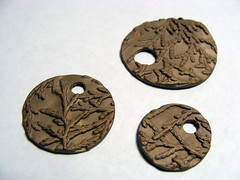Organically Inspired. . .
Search
BRONZclay Success!
 Thanks to some great advice from Bill Struve and several other members of our metal clay community, I have successfully fired BRONZclay! My strategy was to focus on the two most likely problems, which were temperature and carbon. I’ve suspected that my kiln might run a bit hot, so I backed off to 1500 for the hold temp. I also switched to the coconut carbon that I’ve used to successfully fire COPPRclay. These three test pieces are fully sintered with no blisters and not even the tiniest of cracks. Wahoo!
Thanks to some great advice from Bill Struve and several other members of our metal clay community, I have successfully fired BRONZclay! My strategy was to focus on the two most likely problems, which were temperature and carbon. I’ve suspected that my kiln might run a bit hot, so I backed off to 1500 for the hold temp. I also switched to the coconut carbon that I’ve used to successfully fire COPPRclay. These three test pieces are fully sintered with no blisters and not even the tiniest of cracks. Wahoo!
My next test will be fired in a new batch of coal carbon, which should arrive later this week. I really want to fire in coal carbon to get those amazing colors right out of the kiln. I’m learning that the coal carbon is an inconsistent firing media. From what I’m told, you might buy a batch from a source today that works perfectly, and buy another batch next month that doesn’t work. I don’t think it reflects on the vendor when you get a bad batch. It seems to be just the luck of the draw.
Of course, I’m just trying to piece together all of the information that’s flowing in. I’ll post again after the next test. Many thanks to you all!






Yeah !!!!! 😉
I am so happy it work this time !!
Every kiln is different, therefor the firing schedule for everyone may vary.
Welcome to the incredible world of Bronzclay!!!!
Thanks, Lorena. I really appreciate your support.
Hi! I wish I had known sooner that you were having trouble so I could have tried to help. Fortunately, it looks like you’ve gotten a lot of good advice!
Based on a firing problem I had recently, I’d suggest that when your new batch of coal-derived carbon arrives, you pre-fire it. Depending on how long it has been sitting around in the bag, and the conditions in which it has been stored, it may have “adsorbed” (absorbed on the outside) some moisture that can interfere with proper sintering. (Big thanks to Mardel Rein for helping me solve this problem recently!)
Also, many people have found that loading your pieces into the carbon on their edges (vs. laying them down flat) helps with successful sintering.
It’s also important to make sure there is enough carbon around each piece in every direction – top, bottom, and all 4 sides. I usually leave a 1″ layer of carbon around each piece, just to be safe.
You didn’t mention whether you were using a top-loading or side-loading kiln, or a brick vs. a ceramic muffle kiln, but those things will make a difference in the firing schedule. A brick kiln retains heat much better than ceramic fiber, so a lower target temperature usually is needed. Ramp speed matters, too, particularly for the last 300F towards the target temp. See my Squidoo BRONZclay lens for Tonya’s firing schedule. Some people prefer to just ramp slowly the entire way and let the cycle run overnight.
I’d also suggest not crash cooling your BRONZclay pieces but letting them cool naturally until the kiln is cooler than 500F (or room temp, if you fire overnight).
As Bill said, cracks are normal in BRONZclay, and many of us just assume we will be patching and re-firing at least once.
The new FASTfire BRONZclay (my Squidoo lens on that will be coming soon) is quite different, and I had no cracking problems with it. It also fires much faster, is a LOT easier to work with (great consistency, minimal conditioning, sticks to itself readily for joins, and more). So unless you’re doing a lot of carving, for which I think BRONZclay is superior, you may want to switch to the new FASTfire BRONZclay formula. I think you’ll love it!
Best of luck and let us know how you fare!
Margaret
Thanks, Margaret, for your detailed response. I got a sample of the FastFire Bronze at the PMC Conference, and I’m looking forward to testing it. I also bought the “Magic Carbon” from Cool Tools, which allowed me to successfully fire a piece of the original BRONZclay with a full ramp fired for 2 hours. I was shocked and amazed! More experiments to come!